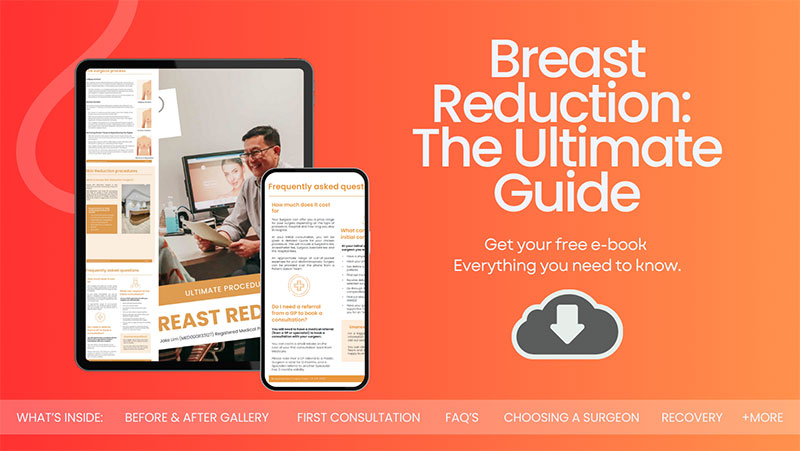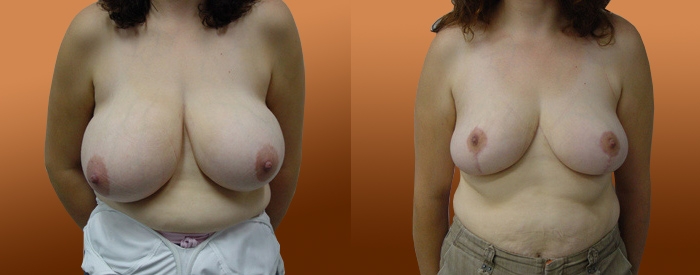Breast Reduction Surgery to Reduce Overly Large Breasts Causing Neck and Shoulder Pain
In today’s fast-paced world, chronic neck pain has become a common complaint, often attributed to long hours at the desk, poor posture, or even stress. However, for many women, the root cause of this persistent discomfort lies not in their daily routine but in their anatomy. Overly large breasts, a condition medically termed as ‘macromastia’ or ‘breast hypertrophy,’ can exert significant strain on the neck and upper back, leading to debilitating pain and postural changes. As awareness grows, an increasing number of individuals are exploring breast reduction surgery as a potential solution to this chronic ailment. In this blog, we discuss the scientific connection between large breasts and neck pain, drawing insights from two pivotal studies that shed light on the profound impact of breast size on spinal health.
With years of experience and a deep understanding of the intricate anatomy of the breast, Sydney Specialist Plastic Surgeon Dr Jake Lim has successfully performed hundreds of breast reduction procedures, alleviating the physical discomfort associated with overly large breasts.
Dr Lim’s 2024 Breast Reduction Guide

The Connection between Neck Pain and Large Breasts
The human body is a marvel of balance and biomechanics. Every part, from the smallest toe to the largest organ, plays a role in maintaining this equilibrium. However, when one part becomes disproportionately large, it can disrupt this delicate balance, leading to a cascade of physical issues. Such is the case with overly large breasts, medically termed as ‘macromastia’ or ‘breast hypertrophy’.
Women with macromastia often bear the weight of their breasts both physically and emotionally. The excessive weight and gravitational pull of large breasts can place immense strain on the neck, shoulders, and upper back. This strain can lead to chronic pain, muscle tension, and even skeletal deformities over time. Biomechanically, the spine tries to compensate for the added weight at the front by altering its natural curvature, leading to postural changes. This altered posture can exacerbate the strain on the neck and upper back muscles, making daily activities painful and strenuous.
Moreover, the skin and soft tissues of the shoulders can show signs of distress, with deep, painful grooves forming from bra straps struggling to support heavy breasts. Beyond the physical discomfort, the constant pain can impact daily life, restricting activities, and may even affect mental well-being. As awareness of this connection grows, many women are seeking medical interventions, such as breast reduction surgery, to alleviate the pain.
Study Insights: The Connection between Neck Pain and Overly Large Breasts
A study discussed in the article titled “Relationship between Brassiere Cup Size and Shoulder-Neck Pain in Women” from PubMed Central (PMC) aimed to examine the correlations among breast size, brassiere cup size, and moment-in-time reporting of shoulder-neck pain in adult women. The research involved 339 female volunteers from hospital staff. The findings revealed no significant relationship between shoulder-neck pain and brassiere cup size when considered individually. However, when participants were grouped into small and large brassiere cup sizes, a significant positive correlation was found between shoulder-neck pain and large brassiere cup size. Interestingly, no significant relationship was observed between shoulder-neck pain and breast size. The study concluded that a large brassiere cup size is an important cause of shoulder-neck pain.
Key Takeaways:
- Women with large breasts often report skeletal system complaints, such as neck strain, headache, aching shoulders, and more. These symptoms tend to disappear after reduction mammoplasty
- Large breasts can cause upper back pain by altering the spine’s curvature. Women with larger breast cup sizes (D and above) tend to have greater spine curvatures than those with smaller breasts
- The weight of the breasts (brassiere cup size) is more significant in relation to shoulder-neck pain than the actual breast size
The Effects of Breast Reduction on Back Pain and Spine Measurements
A detailed study called The Effects of Breast Reduction on Back Pain and Spine Measurements: A Systematic Review discussed the effects of breast reduction on back pain and spine measurements. This review article aimed to synthesise the literature on reduction mammoplasty (breast reduction surgery) and its effects on the spine. The focus was on radiological studies that investigated changes in spinal angles, posture, centre of gravity, and back pain reduction.
Methods: A thorough review of the literature was performed, searching the Medline database for relevant data studying reduction mammoplasty and the spine. Out of 107 articles found, 11 met the specific inclusion criteria.
Results: The studies covered the period from 2005 to 2015 and focused on breast hypertrophy and the spine. According to these studies, breast hypertrophy causes objective disturbances to women living with this condition. Reduction mammoplasty produces a significant improvement in signs, symptoms, and quantifiable measures. While most articles described postoperative improvement in spinal angles, there were discrepancies in the results between them.
Conclusions: The studies provided insights into the complex relationship between breast hypertrophy and the spine. However, there’s a need for more refined, objective, radiological evidence in future research.
Key Insights:
- Breast hypertrophy can cause a range of physical complaints, including neck and upper back pain, poor posture, and difficulty exercising
- The most effective treatment for breast hypertrophy and its associated symptoms is bilateral breast reduction surgery
- The spine tries to maintain balance with the least energy possible. The excessive weight of hypertrophic breasts can disrupt this balance, leading to changes in spinal curvature and persistent pain

Benefits of Breast Reduction Surgery
Breast reduction surgery is more than just a cosmetic procedure. For many women, it’s an important decision that brings a multitude of benefits, both physical and emotional. Here are some of the most notable advantages:
- Alleviation of Pain: One of the primary reasons women opt for breast reduction is to relieve the chronic neck, back, and shoulder pain associated with large breasts. By reducing the weight and size of the breasts, the strain on the musculoskeletal system is significantly diminished, offering immediate and lasting relief
- Improved Posture: Large breasts can lead to a forward-leaning posture, causing spinal curvature and other postural issues. Post-surgery, many women find it easier to stand straighter and taller, leading to a more balanced and confident stance
- Enhanced Physical Activity: Overly large breasts can be a hindrance to physical activities, from jogging to yoga. After surgery, many women may discover a newfound freedom in movement, enabling them to engage in sports and exercises they previously found challenging or uncomfortable
- Reduced Skin Irritations: Large breasts can lead to skin issues, such as rashes or infections in the under-breast area due to friction and trapped moisture. By reducing the breast size, these skin problems often diminish or disappear entirely, leading to increased comfort
In essence, breast reduction surgery offers a comprehensive solution to the challenges posed by macromastia, paving the way for a healthier and more comfortable life.
Considerations before Undergoing Surgery
Getting breast reduction surgery is a significant decision that requires careful thought and consideration. While the benefits are numerous, it’s essential to be well-informed about the entire process, from consultation to recovery. Here are some key points to consider:
- Consultation with a Specialist: Before making any decisions, it’s crucial to consult with a specialist plastic surgeon who regularly performs breast reduction procedures. This consultation will provide an opportunity to discuss your goals, address concerns, and determine the best surgical approach tailored to your needs
- Understanding Potential Risks and Complications: Like any surgical procedure, breast reduction comes with its set of potential risks, including scarring, changes in breast or nipple sensation, asymmetry, and complications related to anaesthesia. It’s essential to discuss these risks with your plastic surgeon and weigh them against the benefits
- Post-Surgery Care and Recovery Time: Recovery from breast reduction surgery can vary from person to person. Generally, patients can expect some swelling, bruising, and discomfort in the initial days post-surgery. It’s essential to understand the recovery timeline, post-operative care, and any restrictions on activities to ensure a smooth healing process
- Cost and Insurance Coverage: Breast reduction surgery can be costly. It’s vital to check with your insurance provider to see if the procedure is covered, especially if it’s deemed medically necessary due to chronic pain or other health issues
- Emotional Preparedness: While the physical changes post-surgery are evident, the emotional journey is equally significant. Adjusting to a new body image can take time, and it’s essential to be mentally prepared for this transition. Seeking support from loved ones or considering counselling can be beneficial
FAQs about Breast Reduction Surgery

What size breasts cause neck pain?
- Breast size and its relation to neck pain can vary among individuals. While there isn’t a specific size that universally causes neck pain, women with larger breasts, especially those with a D cup size or larger, often report more frequent discomfort. The added weight and gravitational pull of larger breasts can place significant strain on the neck and upper back. It’s essential to note that factors like body posture, muscle strength, and overall health can also influence the onset of neck pain, regardless of breast size.
Can bras cause shoulder pain?
- Yes, bras can contribute to shoulder pain, especially if they’re not well-fitted. The primary support of a bra comes from the band, not the straps. If a bra’s band doesn’t fit snugly around the torso, the straps end up bearing more weight, leading to them digging into the shoulders. Over time, this pressure can cause discomfort, indentations, and even pain in the shoulder area.
Can a tight bra cause neck pain?
- A tight bra can indeed contribute to neck pain. If a bra is too tight, it can restrict movement and compress the ribcage, affecting the muscles and nerves in the area. This compression can lead to referred pain in the neck and shoulders. Additionally, a tight bra can alter one’s posture, causing the neck to strain to compensate for the change in spinal alignment.
How do you know if you’re wearing the wrong bra size?
Several signs indicate you might be wearing the wrong bra size:
- The bra band rides up at the back
- The straps dig into your shoulders or slide off
- The cups wrinkle or create a “double bust” effect
- The centre of the bra doesn’t sit flat against the chest
- You experience discomfort, pinching, or pain while wearing the bra. It’s recommended to get professionally measured for a bra at least once a year, as the body can change due to factors like weight fluctuations, ageing, and hormonal changes
Can size C breasts cause back pain?
- While larger breasts, such as D cup and above, are more commonly associated with back pain, size C breasts can also be a potential source of discomfort for some women, especially if they have a petite frame. The weight distribution and the strain it places on the back and shoulders can lead to pain. Other factors, like posture, muscle strength, and overall health, play a significant role in determining whether size C breasts might cause back pain for an individual.
Further Reading about Breast Surgery with Dr Jake Lim
- Read Dr Lim’s Breast Reduction Surgery Page
- Read Dr Lim’s Blog about Compression Bras after Breast Reduction Surgery
- Read Dr Lim’s Blog about Does Medicare Cover Breast Reduction Surgery?
- Read Dr Lim’s Nipple Reduction Surgery Page
- Read Dr Lim’s Post Pregnancy Procedures Page
- Read Dr Lim’s blog about Efficient Methods to Reduce Bruising after Breast Reduction Surgery




